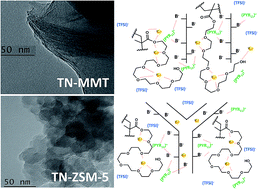Nanocomposite polymer electrolytes based on poly(poly(ethylene glycol)methacrylate), MMT or ZSM-5 formulated with LiTFSI and PYR11TFSI for Li-ion batteries†
Abstract
Novel poly(poly(ethylenglycol)methacrylate) (pPEGMA) nanocomposite electrolytes (NE) based on montmorillonite (MMT) and zeolite (ZSM-5) with lithium bis(trifluoromethanesulfonyl)imide salt (LiTFSI) and 1-butyl-1-methylpyrrolidinium bis(trifluoromethylsulfonyl)imide (ionic liquid, PYR11TFSI) are synthetized using two different routes. Sonication technique is successfully used to introduce the fillers into the polymer matrix, provide uniform dispersion and shatter aggregates of nanofillers to ensure a polymer amorphous structure. The influence of the inorganic particle content (1, 3 and 5 wt%) and filler structure are discussed in terms of their thermal and morphological properties. SEM and TEM techniques reveal an efficient embedding of the fillers into pPEGMA, whereas analyses conducted with TGA/DSC, FTIR and XRD showed that for the binary systems BN-MMT and BN-ZSM-5 containing LiTFSI, the morphology of pPEGMA results into a crosslinking amorphous matrix where Li+ ion motion is hindered. This behavior stems from a strong interaction between the surface of the anionic nanofiller with methylene (CH2) groups from pPEGMA, and particularly anionic nanofiller with Li+. The addition of ionic liquid (IL) PYR11TFSI to ternary systems TN-MMT and TN-ZSM-5 abates the aforementioned interactions and leads to an increase of the interfacial layer separation, which grants flexibility to the polymer chains. These effects stem significantly enhancements in the ionic conductivities of TN-MMT (4.0 × 10−4 S cm−1) and TN-ZSM-5 (9.4 × 10−6 S cm−1) at 30 °C. The lower conductivity obtained for TN-ZSM-5 in comparison to TN-MMT is explained by considering that the introduction of (PYR11)+ to the host channels is blocked, since (PYR11)+ is larger compared to the diameter channel of ZSM-5 (≈0.56 nm), whereby only Li+ ions outside ZSM-5 can be efficiently transferred. Anisotropic conductivity is exhibited for these NE occurring by hopping motion through the formation of a weak coordination shell formed between ether oxygen and carbonyl oxygen from pPEGMA chain. These materials present adequate morphological, thermal and mechanical properties, and a significant enhancement of Li+ ion conductivity for green materials at room temperature to be considered as potential NE for Li-ion batteries.


 Please wait while we load your content...
Please wait while we load your content...